
by Somya Devi | Apr 29, 2022 | Astrology, Conjunctions, Eclipses, Events, Holy Days, Planets Changing Signs
Eclipse Season, Venus-Jupiter Conjunction, and Akshaya Tritiya
There is so much going on in the sky right now, this is an exciting time for astronomers and astrologers alike. Tonight brings a Dark Moon as Sun and Moon approach each other for an exact New Moon conjunction on April 30th at 4:28 pm ET. They join in sidereal Aries, where Sun is exalted and Rahu is currently transiting as well. This meeting of Sun, Moon and Rahu stimulates a solar eclipse around the time of the New Moon, the first eclipse of this spring’s eclipse season, with the lunar eclipse following on the Full Moon of May 15th-16th. Additionally, Venus and Jupiter are having their closest conjunction of the year on April 30th as well!
Aries Moon Cycle
The Aries Moon cycle begins when Sun and Moon join in sidereal Aries. If you’ve forgotten the difference between sidereal and tropical systems, here it is! I just re-read this article and definitely recommend checking it out if this is a concept you strive to understand. The Sun is exalted as it travels through Aries, bringing forth a strong sense of vitality and energy as we emerge into the growing season in the northern hemisphere. The Aries cycle is a time for beginning and giving birth to things, just as we see reflected in nature.
Bharani Nakshatra
This Moon cycle begins literally with Sun and Moon in the Vedic nakshatra Bharani, “the bearer,” the star of birth and death. It is represented by a womb, associated with fertile Venus, ruled by death deity Yama, and opens a portal between the worlds of living and dying. This moon cycle is an opportune time to plant the seeds you are wishing to cultivate, both literally and figuratively.
Akshaya Tritiya
Three days after the New Moon in Aries, on Tuesday, May 3rd, the Moon travels through its sign of exaltation as well— Taurus. A sign of exaltation is the place where a planet is considered extremely well-placed, supported by the ruler of that sign, and in good relationship with its home sign. It’s where the planet is most likely to be able to express itself positively through us. With the Sun exalted in Aries, it is supported by its ruler Mars, a planet that adds courage and strength to Sun who seeks to express power and vitality. With the Moon exalted in Venus-ruled, earth-sign Taurus, it gets to rest on fertile and stable ground, an excellent place for our watery, emotional and often changeable mind to reside in the feminine.
With both Sun AND Moon exalted at the same time, this signals that our minds, bodies, and spirit are extremely well-supported. For this reason, this “tritiya” (third waxing Moon) day is thought to be a day that offers only auspicious, prosperous, everlasting results. Hence it is deemed Akshaya Tritiya, “akshaya” being that which is without loss, that which never diminishes. In India this is a major moment for investments, new beginnings, and large purchases, especially of gold and silver. It is thought that your returns will be “never diminishing.”
Although usually I like to offer specific Muhurta selections based on one’s individual natal chart, this day is generally considered auspicious in general for new endeavors, purchases, and investments.
Solar Eclipse
April 30th, the New Moon, itself brings with it a solar eclipse that will be visible from parts of South America and Antarctica. Its effects, however, can be felt across the globe. You may have already noticed tensions rising in your life this week, especially around certain areas where you have felt stuck. Eclipses are when the shadow energy becomes visible (we literally see a shadow when the grahas Rahu and Ketu align with Sun, Moon and Earth). They tend to bring to light areas that require our attention and change, whether it be by eliminating limiting beliefs or patterns, or by stepping into something we have resisted.
This is the first eclipse of a 1.5-year cycle that began when Rahu and Ketu transited into the Aries-Libra axis on April 12th, after their year-and-half transit of Taurus and Scorpio before that. This longer cycle and the biannual eclipse seasons within it are likely to “bring stuff up” for you in whatever areas of life are indicated by Aries and Libra in your Vedic natal chart, and may stimulate other karma depending upon what other planets are there in your chart.
As in many traditional cultures, in Vedic thought eclipses are considered inauspicious times, because the natural order of the universe is turned on its head. It is best not to plan any important activities or new beginnings during the hours of the eclipse itself (2:25 PM – 6:38 PM ET, with maximum eclipse at 4:42). Instead, spiritual practice such as prayer or meditation is advised, as these are the best remedies for dealing with the disruptive, confusing and often virulent energy of the nodes, Rahu and Ketu. Hindu culture advises against eating, drinking or being outside during the eclipse hours as well, especially if you live in its visible path.

This is the first eclipse of two that are coming this eclipse season, the second being a lunar eclipse on the Full Moon of May 15th-16th, which will be visible from most of the Americas, Europe, Africa and the Middle East. After that the eclipse season ends until the next set which will come in October-November of this year.
Some astrologers advise people to do things around an eclipse as these can be transformative times. They can definitely be transformative, but I always caution clients that if you are to make a major decision during an eclipse season, be sure that it comes from a place of clarity, after much reflection and introspection, and that it is not based out of stress, fear, or overwhelm with your current situation.
Jupiter-Venus Conjunction/War
In addition to the New Moon and Solar Eclipse, Saturday also brings the exact conjunction of Jupiter and Venus, at 5:14 pm ET in sidereal Pisces. The two will be traveling together in this sign from April 27th through May 23rd, when Venus moves into Aries. Jupiter is the ruler of Pisces, while Venus is exalted there, giving the two brightest planets a lot of power right now. It will be a beautiful sight to behold on the early mornings of April 30th and May 1st, while they can be seen extremely close together rising a little while before the Sun. (EarthSky has some great visuals on what to look for in the early morning eastern sky.)
The intense proximity of the two, however, creates what is known as a graha yuddha or planetary war in Vedic astrology. This happens whenever two planets come within one degree of each other, as these two do from April 29th through May 1st. When this happens, both planets are considered to be weakened because they must vie with each other for power and our attention. Thus the areas ruled by Jupiter (inspiration, hope, beliefs) and Venus (happiness, romance, art, beauty, nature) in general and in our personal charts, may suffer during this time.
The war between Jupiter and Venus can be particularly difficult as these two are quite inimical to each other, Jupiter being the guru of the Gods and Venus that of the Asuras (demons). Jupiter or Guru guides us to acquire our higher belief systems, knowledge, and wisdom, while Venus or Shukra motivates us mainly towards pleasure. It is for this reason that Venus becomes exalted in Pisces, because when under Jupiter’s influence, in this other-worldly water sign, we are often able to align our desires with a higher power or purpose.
So enjoy the spectacle of the two brightest planets this weekend, but consider the highest potential of the two as you feel the waves of emotion that may come as they battle it out, with the Moon and eclipsed Sun joining Rahu in fiery Aries. Overall I do believe this whole setup offers a lot of potential for inner growth, if we take the time to go inward and seek insight around our highest purpose, desires, and intentions for this season’s new beginnings.
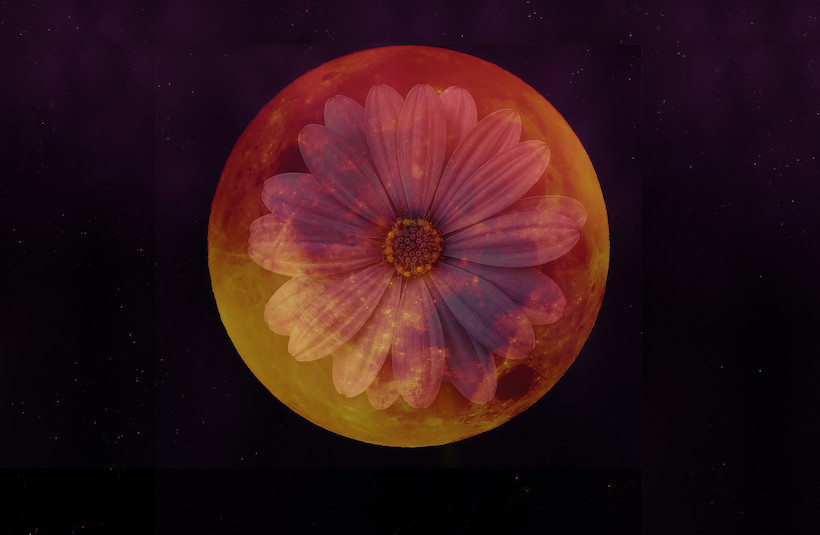
by Somya Devi | May 24, 2021 | Uncategorized
Full Moon and Total Lunar Eclipse
The Full Moon rises in sidereal Scorpio on the night of May 25th, reaching exact opposition to the Sun on Tuesday, May 26th at 7:14 am ET. Its proximity to the lunar nodes, Rahu and Ketu, stimulates a total lunar eclipse, spanning from 4:47 am until 9:49 am, with the maximum eclipse at 7:18 am ET. This eclipse along the Scorpio-Taurus axis could have particularly strong effects on those areas of your life indicated by these signs, dependent on the natal placements of the nodes.
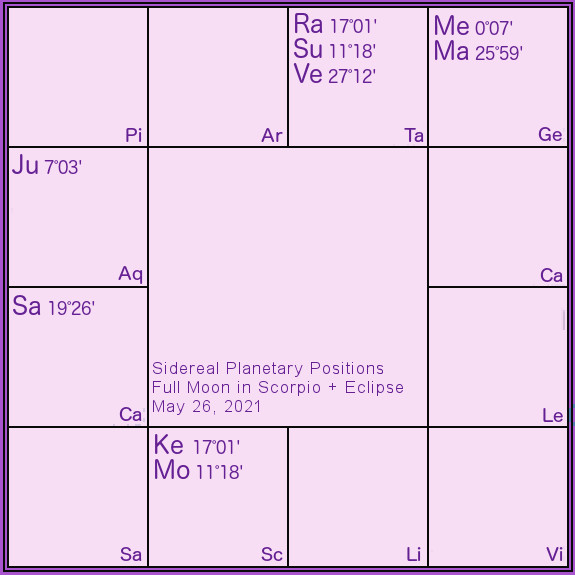
Scorpio Full Moon
The full Moon in Scorpio occurs when the Sun is in sidereal Taurus, a steady earth sign ruled by Venus. When the Moon is illuminated by this light in the opposite sign of Scorpio, an insect-like water sign, the part of us that has a protective shell and likes to scurry into dark places may peak its head out and stand confidently in the light for a moment. Thus, inner strength is available for unfurling, as we allow ourselves to go beneath the surface and accept of the strong emotions that can be found there. Vulnerability is a keyword here, as we realize that we must relax our guard a bit in order to live as our fullest selves.
Anuradha Nakshatra
This full Moon is in Anuradha nakshatra, a star of success and friendship. Ruled by the god Mitra, one of the Adityas, he can bring forth friendship, harmony, and good faith. There is a lot of devotion available under this nakshatra, related to goddess Radha. Those with a natal Moon here may find this full Moon stimulating effects relating to the Moon in your personal chart.
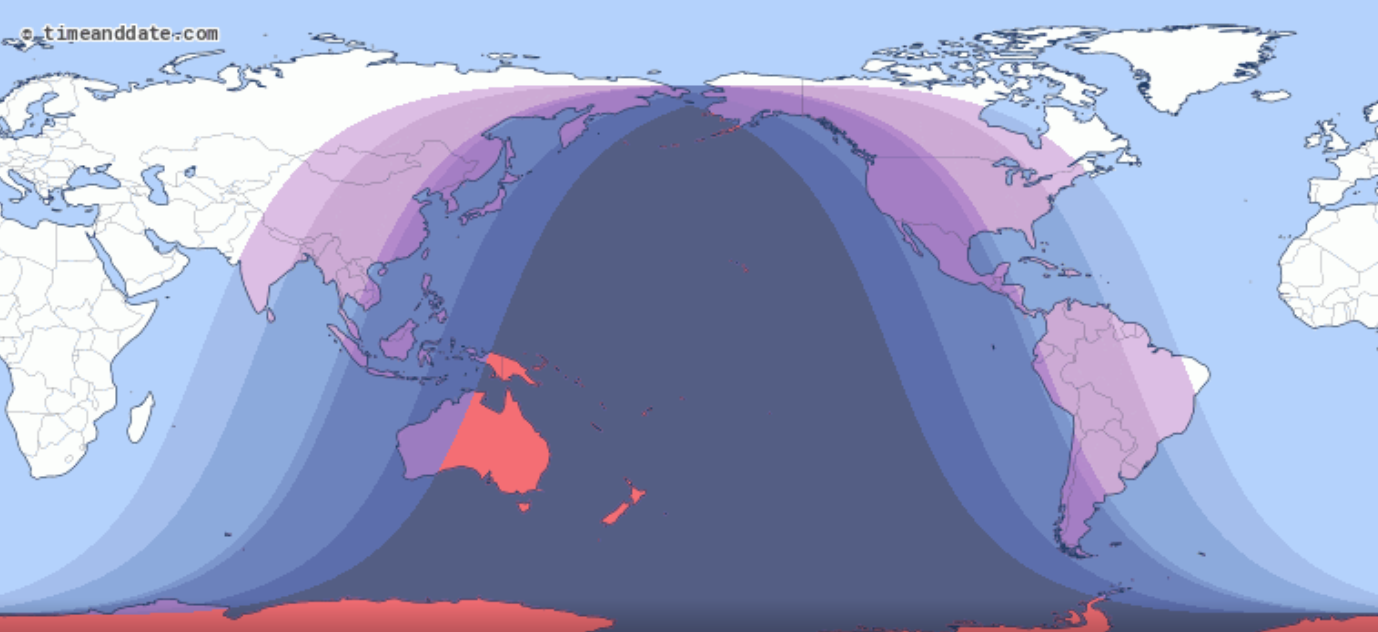
Super Flower Blood Moon
This full Moon and lunar eclipse is being referred to buy many as the Super Flower Blood Moon. The “blood” moon part refers to the red color that will appear as the earth’s shadow passes over the Moon. The map above shows where on earth you will be able to view part or all of the eclipse. The “flower” indication is a western name given to the full Moon occuring during this time of year when many flowers are blooming. The “super” term refers to the Moon’s proximity to earth at this time, making it appear slightly larger and fuller than most other full Moons of the year.
Total Lunar Eclipse
An eclipse of any sort is considered inauspicious in Hindu culture, and many others as well, as the light that usually guides us becomes obscured temporarily. As the Moon relates with our mind and hearts, the mind may feel particularly cloudy as the lunar node, Ketu, casts his energetic shadow over Chandra. The nodes can bring forward “shadows” in our minds, parts of ourselves that we are not normally able or willing to see. This can be a disruptive energy for many people as stress seems to rise and confusion often follows. It is best not to make any rash decisions during the eclipse, especially those based out of stress. But with dedicated spiritual practice that helps one to come to clarity, some large realizations can sometimes occur.
In Hindu culture it is recommended not to look directly at the eclipse, nor to be outside in its light, and neither eat nor drink during the eclipse. Chanting, praying, or meditating are the optimal choices for passing through the eclipse period. This is the first of two eclipses that will occur this cycle, with the second, a solar eclipse, occurring on June 10th. After that the intense energy brought on by the eclipse cycle may dissipate, and we can work on integrating the lessons learned during this time.
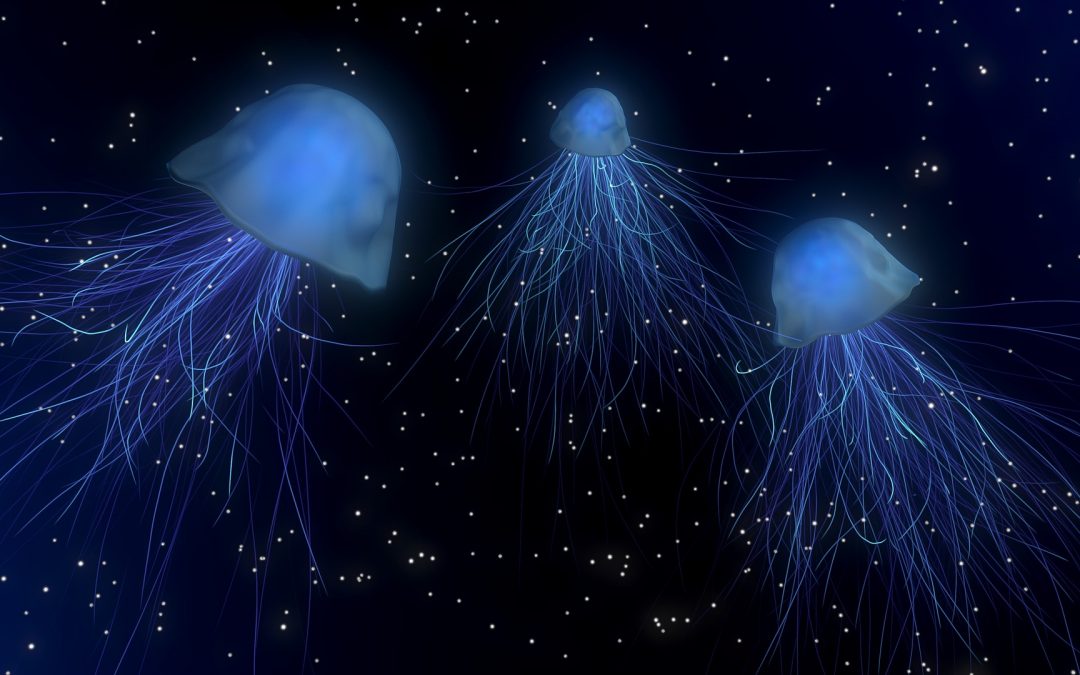
by Somya Devi | Apr 8, 2021 | Astrology, Conjunctions, Holy Days, Planets Changing Signs
New Moon April 2021
The Moon and Sun join to make a New Moon at the very end of sidereal Pisces at 10:31 pm ET on the dark night of Sunday, April 11th. This will begin a lunar cycle in which the Sun spends most of his time in Aries, his sign of exaltation. Jupiter, one of the outer, slower-moving planets, has transited into sidereal Aquarius, breaking rank with Saturn who remains in Capricorn.
Pisces-Aries Cycle
We enter another lunar cycle during which the Sun begins in one sign just two days before entering another, where he will spend most of the lunar cycle. Pisces is the last sign of the natural zodiac, the end, a place where we connect with the unseen world including the underworld itself. Aries, on the other hand, is a place of beginnings, the true springtime energy where the literal sunlight gives life to the world once again and things begin to grow outwardly. This cycle will connect these two worlds for us, bringing much of the subconscious into light as we begin to take on more activity during this season.
The Sun and Moon begin joined with a debilitated Mercury, which can make us pass up practicality in favor of hopes and dreams. Jupiter rules this femenine (inward-looking) water sign.
Revati Nakshatra
The Sun, Moon and Mercury are all in Revati nakshatra as we begin this Moon cycle. The final of the 27 Vedic nakshatras, this sign has to do with journeys, and is ruled by the deity Pushan, the protector of journeys, flocks and herds. We can imagine in particular the journey from life to death as this is the final journey that we all make. Revati means “the wealthy” and is also related to Mercury, Vishnu and Lakshmi. There is a strong association with animals and this nakshatra, and many people with planets here have a strong love of pets or animals.
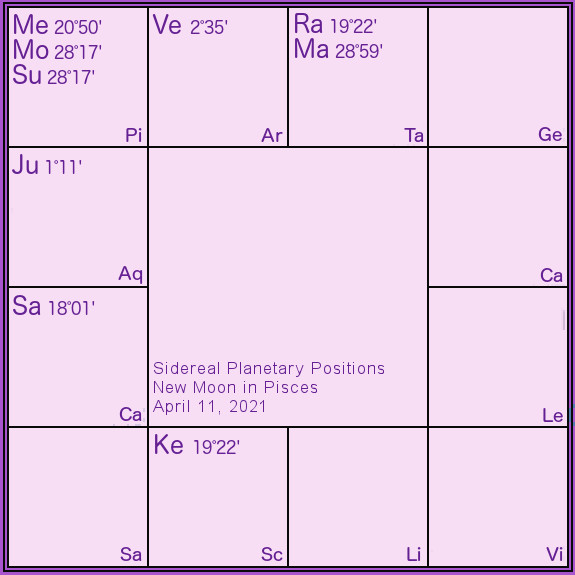
Jupiter Transit
Jupiter has moved from sidereal Capricorn into Aquarius, lightening his load as he is no longer in his sign of debilitation and joining the heavy presence of Saturn. Jupiter in Aquarius could stimulate some expansion in social programs, scientific innovations, and forward-thinking across society. This new position could stimulate some movement in your life depending on natal planetary positions and the current dasha (planetary period) and bhukti (sub-period) you are running according to your chart.
Mars Transit
Mars will leave Taurus just hours after the New Moon, finally parting ways with Rahu, lessening some of the intensity that has built up around their conjunction the past couple of months. His movement will also break the Kala Sarpa cycles, although with only one outlier the nodal alignment can still bring some intensity to current events or those born with these placements in the birth chart.
Chaitra Navaratri
This New Moon is followed by nine nights that are the springtime celebration of the goddess known as Chaitra Navaratri. These nights are celebrated in homage to the divine mother in her many forms, particularly Durga. This is not as largely celebrated as the fall-time Navaratri (Sharad or Maha Navaratri), but is also significant. This leads us up to Hanuman Jayanti which will be celebrated around the time of the next full Moon.
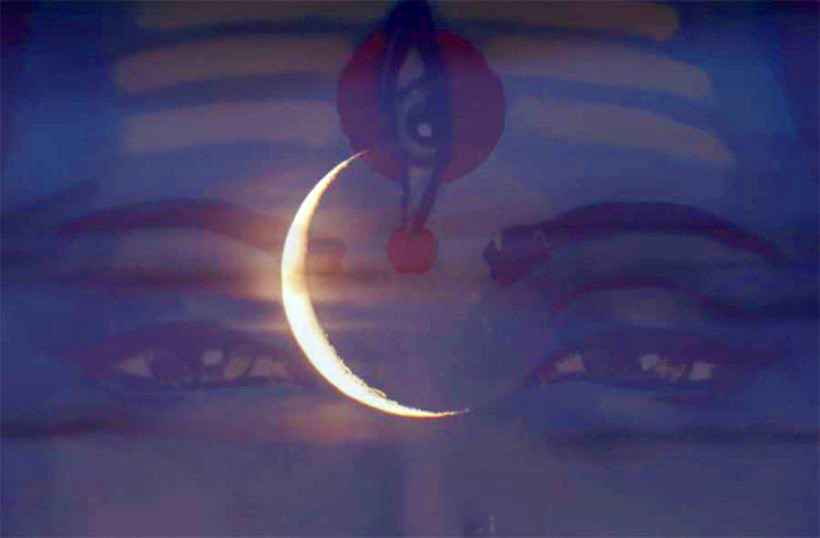
by Somya Devi | Mar 11, 2021 | Astrology, Conjunctions, Holy Days
New Moon and Maha Shivaratri, March 2021
The Sun and Moon join near the end of sidereal Aquarius on the dark night of March 12th, with an exact alignment under the New Moon at 5:21 am ET on Saturday, March 13th. Mercury and Venus also join the Moon and Sun in Aquarius, while Saturn (with Jupiter in sidereal Capricorn) once again rules over 6 grahas at the time of the New Moon. Mars and Rahu continue their conjunction in sidereal Taurus, opposite Ketu in Sagittarius, forming a Kala Sarpa Yoga in the sky. Thursday night, the fourteenth night of the waning Moon, marks the Maha Shivaratri celebration this month. Sun and Moon begin this cycle in the Vedic nakshatra Purva Bhadrapada, an auspicious sign for spiritual advancement.
Aquarius Cycle
With the new lunar cycle beginning in Aquarius, the coming month may have a quirky and forward-thinking tone, and we may see some scientific advances this month. The Mars Rover landing actually occurred just days after the Sun had entered its Aquarius cycle. Aquarius is in fact very much about service to the greater good. With Saturn strong in his own sign, we could see many significant advances in social support structures right now.
Aquarius is known as Kumbha in Sanskrit, a word for “pitcher” or “vessel.” According to the Vedic texts, the sign Kumbha can be imagined as a man holding a pot, with deep-brown skin, standing in the water. We can see this Aquarian imagery in the sadhus of India (and its biggest ritual pilgrimage day, the Kumbha Mela), who make their lives an offering of service to society through their prayers and Saturnian austerities, while renouncing the individual self. In the Aquarius cycle, we think about how we can serve the whole.
Maha Shivaratri
Thursday night, March 11th in North America, the night prior to the Dark Moon night, is the fourteenth waning phase of the lunar cycle. During this month this night is celebrated as Maha Shivaratri. This is the most auspicious night of the year for doing sadhana (spiritual practice). It is traditional on this night to stay up all night fasting, chanting, praying, and meditating. This holiday honors Lord Shiva, the great ascetic, as we recall two stories of great sacrifices that he made protect the entire creation.
One of these is the story of the gods and demons churning of the milk ocean in order to release the nectar of immortality. Before the nectar came up, however, a poison came up first. (This is similar to when we do spiritual practice and begin our path of self-inquiry, and negative tendencies often come to light first, which can be a painful experience. Similarly, during a physical fast or cleanse, toxins can be shaken loose and released first, causing a healing crisis before we continue healing into a freer, happier state of being.) When the poison came up from the milk ocean, Lord Shiva consumed it so that it would not engulf humanity, as a great and noble sacrifice. His wife, Parvati, however, held his throat so that he could not ingest it, thus saving him from being harmed by the poison.
Maha Shivaratri also commemorates the wedding of Shiva and Parvati, which also stemmed from great sacrifice made for the benefit of all humanity. It was said that after his first wife, Sati, perished, Shiva was fully devoted only to his sadhana, meditating for aeons in isolation and renouncing the world. Then the demon Tarakasura began running amock on earth, threatening all of humanity. Brahma foretold that only Shiva’s child could defeat Tarakasura, so the gods devised a plan for Sati to reincarnate as Parvati, and win over her Lord to marriage once again to produce this heir. Shiva was not easily swayed, however, and it was only after Parvati became an ascetic and underwent great penance that he agreed to marry. They eventually produced their son Kartikkeya, who went on to slay the demon.
Thus, this holiday is celebrated through the penance of fasting, forgoing food, water, and sleep, for one night, and simultaneously celebrating the union of Lord Shiva and Parvati, or the masculine and feminine energies of creation, that allows the dance of life to continue. It is an apt time to feel the forces of Aquarius upon us, which compel us to consider our role in society, and in the universe, and what personal sacrifices we can make for the greater good. Even if you’re not able to stay up the whole night, any amount of devotional practice, serviceful sacrifice, or chanting of Om Namah Shivaya on this night can have beneficial affects that are magnified greater than on any other night.
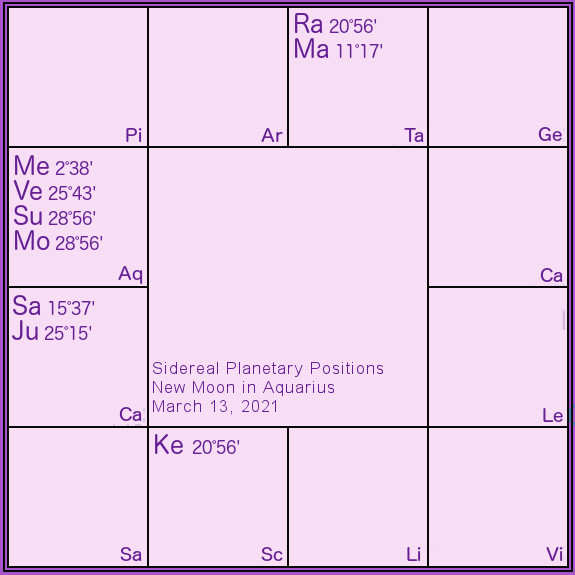
Kala Sarpa Yoga
This year’s Kala Sarpa yoga cycles continue, as Rahu and Ketu appear to cut the sky in half with all planets to one side of the nodal axis. Kala Sarpa can be translated as “black snake” or the “serpent of time,” and intensifies subtle forces on all levels, including inner challenges as well as strengths and yogic combinations in a chart. Mars joins Rahu in Taurus, and tho he will transit out of Taurus and into Gemini in one month, technically breaking the cycle, the intensity brought on by the alignment can sometimes continue when only one planet has crossed to the other side of the sky.
Purva Bhadrapada
The former “lucky-footed one” is the Vedic nakshatra (star-sign) where Sun and Moon begin this lunar cycle. This nakshatra bridges Aquarius and Pisces and is often represented by a funeral cot, symbolizing the transition from life into death, or ultimate liberation. It is ruled by Aja Epakada, the one-footed goat who is often associated with the image of Lord Shiva as Nataraj dancing on one foot, a fitting image for Maha Shivaratri.
Om Namah Shivaya!
Personal Chart Readings with Coaching Are Available Here

by Somya Devi | Jan 28, 2021 | Astrology, Conjunctions
Full Moon January 2021
The full Moon peaks in sidereal Cancer at 2:16 pm EST on January 28th, opposite the Sun, Saturn, Jupiter, and Venus, all in sidereal Capricorn. This bright Moon illuminates the sign of the heart and the mother, while standing alone in the sky and receiving the aspects of three malefics (Sun, Saturn and Mars), as well as Jupiter and Venus. This alignment challenges us to let the heart shine with pure, unconditional love, while under the influences of stern authoritarianism, the fires of purification and courage, the conditional love of Venus, and the weakened inspiration of Jupiter. This quest is emphasized by Moon’s position in the Vedic nakshatra of Pushya, the nourisher. Read on for more explanation!
Full Moon in Cancer
The Sun traverses Capricorn this cycle, an earth sign ruled by Saturn that brings us into our power by instilling a sense of responsibility, hard work, and structure. It can feel like a lot of pressure sometimes, especially with Saturn transiting there as well, adding a strong, somber tone of maturity to our mental dialogue while he is here (all of last year and this). The opposite, Cancer, is where we find comfort, ease and an open heart, as if nuzzling into the arms of the mother. It is this sensation that is illuminated with the full Moon in Cancer, but, there is a lot of pressure coming from the other influencing planets that may make it feel difficult to stretch open those arms and receive the purity of heart that Cancer has to offer, at least without dismantling some of the entanglements that surround.
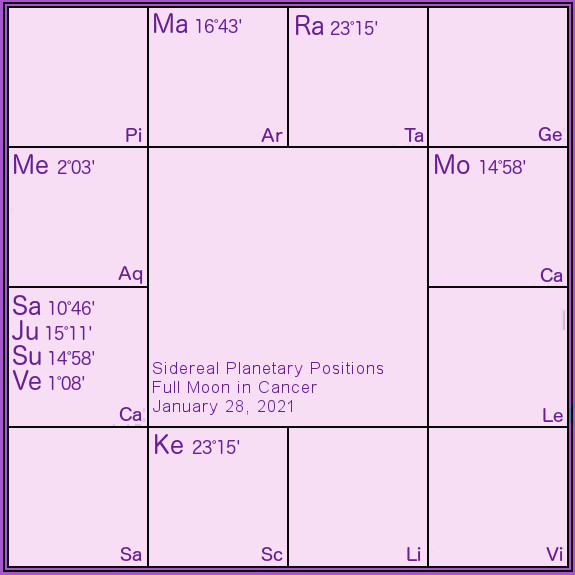
Compounding Influences
In Cancer, this full Moon stands alone, without any planets nearby. Though it is in its own home sign here and gains strength from that, there is a certain loneliness when Moon does not have any planets nearby. Furthermore, the Moon receives direct aspects from Jupiter (combust and debilitated, though neecha bangha), Saturn (sva, in his own sign), Sun, Venus, and Mars (also sva in his own sign of Aries).
The aspect from Mars in Aries can add fire, courage, and a sense of fight to our minds and hearts, that would prefer to be gentle with Moon in watery Cancer. The influence of Sun in direct aspect is what makes the Moon full, in fact, but is still a malefic that challenges us to purify ourselves, often through fire and heat, in order to reveal our pure essence and inner strength. Saturn’s direct aspect is strong because he is in his own sign… a position which has been wreaking havoc on the world through restriction and contraction over the last year. Saturn’s influence on the Moon limits the heart from expanding to its fullest, adding a weight of heaviness, a even a looming sense of doom, keeping us tethered to outward pressures and responsibilities when we wish to go inward, expanding into our inner sanctuary instead.
Jupiter’s presence and aspect does give some inspiration and hope, but even this is dampened by his debilitated position in Capricorn (though somewhat modified and elevated by the presence of Saturn… keeping us grounded to a healthy degree in our inspiration), and by his highly combust position only a fraction of a degree from the Sun (behind the Sun, from our perspective here on earth). That increases the Sun’s power of purification and asks us to burn away what does not serve in helping the heart achieve full openness and connection with the inner sanctity.
Venus’s aspect onto the Moon also influences the heart and mind slightly away from Cancer’s optimal goal of unconditional love, and brings in preferences, pleasures, and the sense of “deserving” something from those we love. Since the outside world often falters in fulfilling our sense of entitlement, Venus aspecting the Moon in Cancer can cloud that unconditional heart with a set of expectations that will create some guarding.
Pushya Nakshatra
The Moon’s position in Pushya nakshatra continues this theme, asking us to examine unconditional parental love and seeking to find it despite difficult circumstances. Pushya literally means “the nourisher,” and is represented by the nourishing udder of a cow that offers so much sustenance.
It is ruled by the deity Brihaspati (Jupiter), and relates with the story of him adopting Budha (Mercury), the love-child born of Jupiter’s wife Tara and Chandra (the Moon). Despite circumstances, the sattvic Brihaspati loved the child as his own, setting an example of divine parentage without conditions. We must remember, however, that the human relationships of our limited selves, opening the heart without conditions can often result in feelings of disparate give and take—feeling one has been taken advantage of, had boundaries violated, or abuses of kindness and openness.
Our work on this full Moon is to dive as deeply into the heart as we can, and opening it within a safe place. We must strive to connect with the energy of the Divine Mother while examining all aspects of complication that surround our relationship with her (or with our own personal mothers, or fathers).
Personal Chart Readings with Coaching Are Available Here











